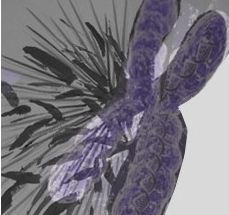Can protein 14-3-3 sigma prevent or kill breast cancer tumors?
MD Anderson study shows potential of simple molecule in cancer metabolism
Every parent knows the maxim "feed a cold, starve a fever." In cancer, however, exactly how to feed or starve a tumor has not been easy to determine.
A study led by scientists at The University of Texas MD Anderson Cancer Center has shown that a simple molecule called 14-3-3 sigma could be one answer for explaining cancer metabolism, the chemical process by which a tumor forms, grows or dies.
"We know that all cancers grow by learning how to reprogram their metabolism," said Mong-Hong Lee, Ph.D., professor of Molecular and Cellular Oncology. "But exactly how this occurs has not been fully understood. Our study showed that 14-3-3 sigma opposes and reverses tumor-promoting metabolic programs."
Lee's study results, which appeared in the July 16, 2015 issue of Nature Communications, revealed new understanding about how 14-3-3 sigma - a cell cycle "controller" -regulates cancer metabolic programming, thus protecting healthy cells from turning into tumor-producing factories.
In vivo and in vitro experiments showed that, among many biochemical effects, 14-3-3 sigma suppresses cancer glycosis, which prevents cancer's ability to convert glucose into pyruvate, a substance essential for cell growth.
"14-3-3 sigma expression levels can help predict overall and recurrence-free survival rates, tumor glucose uptake, and metabolic gene expression in breast cancer patients," said Lee. "These results highlight that 14-3-3 sigma is an important regulator of tumor metabolism, and loss of 14-3-3 sigma expression is critical for cancer metabolic reprogramming."
Lee believes that the study findings provide additional insight about the "crosstalk" between cancer metabolism and cell cycle.
"We anticipate that pharmacologically elevating 14-3-3 sigma's function in tumors could be a promising direction for targeted anti-cancer metabolism therapy development in the future," he said.
Most read news
Organizations
Other news from the department science

Get the life science industry in your inbox
By submitting this form you agree that LUMITOS AG will send you the newsletter(s) selected above by email. Your data will not be passed on to third parties. Your data will be stored and processed in accordance with our data protection regulations. LUMITOS may contact you by email for the purpose of advertising or market and opinion surveys. You can revoke your consent at any time without giving reasons to LUMITOS AG, Ernst-Augustin-Str. 2, 12489 Berlin, Germany or by e-mail at revoke@lumitos.com with effect for the future. In addition, each email contains a link to unsubscribe from the corresponding newsletter.




















































